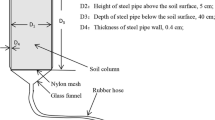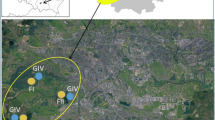Abstract
Intact rich fen soil cores with controlled water levels near thesurface were installed in an open greenhouse. To simulate short termsummer drought, water levels were lowered (20 cm) after two weeks inhalf of the cores (experimental cores) and remained near the surface inthe other half (blanks). After two more weeks, the water levels werebrought back to the surface in the experimental cores and remainedthere for another two weeks. In the blanks, reduction and alkalinizationof the top peat layer occurred. In the experimental soil cores oxidationand acidification started within one week after drawdown. An indicationfor a drought induced rise in soluble reactive phosphorus has beenfound. The velocity of the acidification process illustrates the dynamicnature of the hydrochemical conditions in fen soils during drought. Theprocesses controlling the acid/base status of rich fen, the effect ofdrought induced acidification on P availability and the significance forthe vegetation are discussed.
Similar content being viewed by others
References
Berkheiser VE, Street JJ, Rao PSC & Yuan TL (1980) Partitioning of inorganic orthophosphate in soil-water systems. CRC Crit. Rev. Env. Contr. 10: 170–224
Boeye D & Verheyen RF (1992) The hydrological balance of a ground-water discharge fen. J. Hydrol. 137: 149–163
Boeye D & Verheyen RF (1994) The relation between vegetation and soil chemistry gradients in a ground water discharge fen. J. Veg. Sci. 5: 553–560
Boeye D, Clement L & Verheyen RF (1994) Hydrochemical variation in a ground-water discharge fen. Wetlands 14: 122–133
Boeye D, Van Haesebroeck V, Verhagen B, Delbaere B, Hens M & Verheyen RF (1996) A local rich fen fed by calcareous seepage from an artificial river water infiltration system. Vegetatio, in press
Boeye D, Vanstraaten D & Verheyen RF (1995) A recent transformation from poor to rich fen caused by artificial ground water recharge. J. Hydrol. 169: 111–129
Bournerias M (1990) Un site botanique à préserver: le marais de Bourget à Cervières (Hautes Alpes, France). B. Soc. Bot. Fr-Lett. 137: 293–303
Brady NC (1974) The Nature and Properties of Soils. Macmillan Publishing Co. Inc., New York
Bultot F & Dupriez GL (1974) L' évapotranspiration potentielle des bassins hydrographiques en Belgique. Institut Royal Meteorologique de Belgique, Brussels, Belgium. Publications, Série A, No 85
Cnudde JP (1978) Hydrogeologische studie van het plassengebied van Mol. State University, Ghent
Cook JM, Edmunds WM & Robins NS (1991) Groundwater contribution to an acid upland lake (Loch Fleet, Scotland) and the possibilities for amelioration. J. Hydrol. 125: 111–128
Cottenie A, Verloo M, Kiekens L, Velghe G & Camerlynck R (1989) Chemical Analysis of Plants and Soils. Laboratory of Analytical and Agrochemistry, State University, Ghent
DeVito KJ & Dillon PJ (1993) The influence of hydrologic conditions and peat oxia on the phosphorus and nitrogen dynamics of a conifer swamp.Water Resour. Res. 29: 2675–2685
Driscoll CT, Effler SW, Auer MT, Doerr SM & Penn MR (1993) Supply of phosphorus to the water column of a productive hardwater lake: Controlling mechanisms and management considerations. Hydrobiologia 253: 61–72
ECC (1991) EUR 12587-CORINE biotopes manual: Amethod to identify and describe consistently sites of major importance for nature conservation. Data specification: volume 3. Office for Official Publications of the European Communities, Luxembourg
Fojt WJ (1995) The nature conservation importance of fens and bogs and the role of restoration. In: Wheeler BD, Shaw SC, Fojt WJ & Robertson RA (Eds) Restoration of Temperate Wetlands (pp 33–48). Wiley & Sons, Chichester
Freeman C, Lock, MA & Reynolds B (1993) Fluxes of CO2, CH4 and N2O from a Welsh peatland following simulation of water table drawdown: Potential feedback to climatic change. Biogeochemistry 19: 51–60
Gorham E. (1991) Northern peatlands: Role in the carbon cycle and probable responses to climate warming. Ecol. Appl. 1: 182–195
Grootjans AP, Schipper PC & Van Der Windt HJ (1986) Influence of drainage on Nmineralization and vegetation response in wet meadows: II. Cirsio-Molinietum stands. Ecol. Plant. 7: 3–14
Houba VJG, van der Lee JJ, Novozamsky I & Walinga I (1989) Soil and Plant Analysis, a Series of Syllabi. Part 5. Soil Analysis Procedures. Agricultural University, Wageningen
Houghton JT, Callander BA & Varney SK (1992) Climate Change 1992, the Supplementary Report to the IPCC Scientific Assessment. Intergovernmental Panel on Climate Change. Cambridge University Press, Cambridge
Kemmers RH & Jansen PC (1988) Hydrochemistry of rich fen and water management. Agr. Water Manage. 14: 399–411
Kenoyer GJ & Anderson MP (1989) Groundwater's dynamic role in regulating acidity and chemistry in a precipitation-dominated lake. J. Hydrol. 109: 287–306
LaZerte BD (1993) The impact of drought and acidification on the chemical exports from a minerotrophic conifer swamp. Biogeochemistry 18: 153–175
Lucas RE & Davis JF (1961) Relationships between pH values of organic soils and availabilities of 12 plant nutrients. Soil Sci. 92: 177–182
Patrick WH & Khalid RA (1974) Phosphate release and sorption by soils and sediments: Effect of aerobic and anaerobic conditions. Science 186: 53–55
Richardson CJ & Marshall PE (1986) Processes controlling movement, storage and export in a fen peatland. Ecol. Monogr. 53: 279–302
Roelofs JGM (1991) Inlet of alkaline river water into peaty lowlands: Effects on water quality and Stratiotes aloides L. Stands. Aquat. Bot. 39: 267–293
Schafran GC & Driscoll CT (1990) Porewater acid/base chemistry in near shore regions of an acid lake: The influence of groundwater imputs. Biogeochemistry 11: 131–150
Schneider SH, Mearns L & Gleick PH(1992) Climate-change scenarios for impact assessment. In: Peters RL & Lovejoy TE (Eds) Global Warming and Biodiversity (pp 38–55). Yale University
Sparling JH (1966) Studies on the relation between water movement and water chemistry in mires. Can. J. Bot. 44: 747–758
Stumm W & Leckie JO (1971) Phosphate exchange with sediments; its role in the productivity of surface waters. Adv. Water Pol. Res. 2: 1–16
Stumm W & Morgan JJ (1981) Aquatic Chemistry (2nd ed). Wiley & Sons, New York
van Breemen N (1987) Effects of redox processes on soil acidity. Netherlands Journal of Agricultural Science 35: 271–279
vanWirdum G (1991) Vegetation and Hydrology of Floating Rich-Fens. Datawyse, Maastricht
van Wirdum G (1993) An ecosystems approach to base-rich freshwater wetlands with special reference to fenlands. Hydrobiologia 265: 129–153
Vitt DH & CheeWL (1990) The relationship of vegetation to surface water chemistry and peat chemistry in fens of Alberta, Canada. Vegetatio89: 87–106
Wassen MJ, Barendregt A, Bootsma MC & Schot PP (1989) Groundwater chemistry and vegetation gradients from rich fen to poor fen in the Naardermeer (the Netherlands). Vegetatio 79: 117–132
WassenMJ, Barendregt A., Palczynski A., De Smidt JT & De Mars H (1990) The relationship between fen vegetation gradients, groundwater flow and flooding in an undrained valley mire at Biebrza, Poland. J. Ecol. 78: 1106–1122
Webster KE, Newell AD, Baker LA & Brezonik PL (1990) Climatically induced rapid acidi-fication of a softwater seepage lake. Nature 347: 374–376
Wheeler BD & Shaw SC (1995) A focus on fens: Controls on the composition of fen vegetation in relation to restoration. In: Wheeler BD, Shaw SC, Fojt WJ & Robertson R A (Eds) Restoration of Temperate Wetlands (pp 49–72). Wiley & Sons, Chichester
Wheeler BD (1988) Species richness, species rarity and conservation evaluation of rich-fen vegetation in lowland England and Wales. J. Appl. Ecol. 25: 331–353
Author information
Authors and Affiliations
Rights and permissions
About this article
Cite this article
VAN HAESEBROECK, V., BOEYE, D., VERHAGEN, B. et al. Experimental investigation of drought induced acidification in a rich fen soil. Biogeochemistry 37, 15–32 (1997). https://doi.org/10.1023/A:1005767505058
Issue Date:
DOI: https://doi.org/10.1023/A:1005767505058




